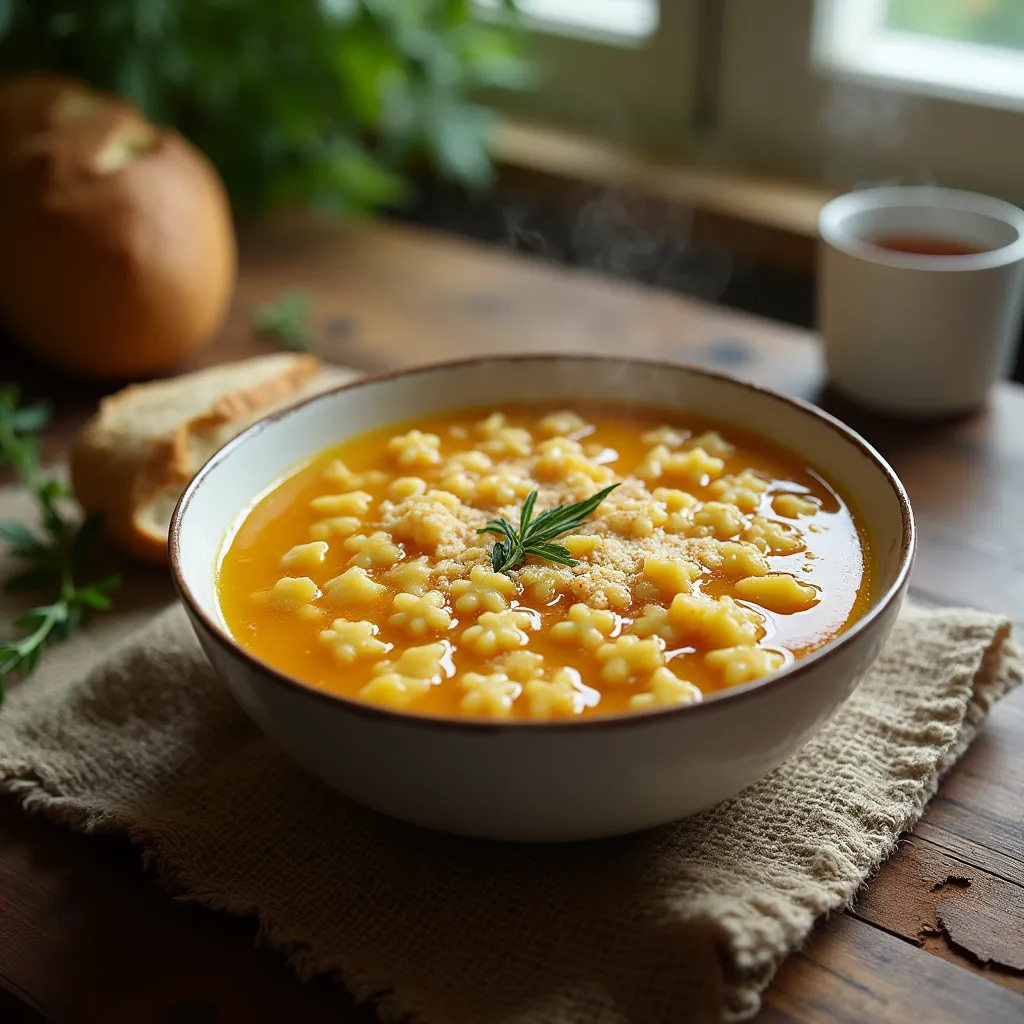
Table of Contents
The Comfort of a Bowl of Pastina
There are few things in life that hit as deeply as the warmth of a homemade soup when you’re not feeling your best. For many Italian families, there’s one dish that embodies this comfort more than any other: pastina soup. Known lovingly as “Italian Penicillin Soup,” this humble yet heartwarming recipe has long been passed down through generations. It’s not just a meal; it’s a ritual of care, healing, and tradition.
Maybe you’ve heard the term tossed around, or maybe your nonna whispered it with a wink. Either way, there’s a reason why pastina soup holds such a cherished spot in Italian homes—and today, you’re going to discover not just why it’s so beloved, but also how to make it yourself.
What Is Italian Penicillin Soup?
The Meaning Behind the Name
When someone refers to “Italian Penicillin Soup,” they’re usually talking about a simple pastina soup, often made with chicken broth, tiny pasta, and a sprinkle of cheese. It’s called “penicillin” not because it contains any antibiotics, but because it’s seen as a natural cure-all—Italy’s answer to chicken soup. Whether you’re battling a cold or the blues, this soup is what many Italians swear by.
This isn’t just some internet nickname. In Italian culture, food is medicine. When you’re sick, your family doesn’t just offer tissues or tea—they make soup. And this specific soup has gained its reputation as a comforting, healing dish thanks to decades of devoted home cooks.
A Symbol of Healing and Love
Pastina soup is often the first solid food fed to babies and the last dish a nonna might make for her family. Its simplicity is its power. It’s easy to digest, warm, and infused with the kind of love you can taste. That’s why so many people equate it with healing. It’s not just the ingredients—it’s the intent behind them.
What Is Pastina? Understanding the Tiny Pasta That Makes It Special
Little Pasta, Big Love
The word “pastina” literally means “little pasta” in Italian. And that’s exactly what it is: tiny pieces of pasta, often in star shapes (stelline), small beads (acini di pepe), or other miniature forms. These tiny shapes cook quickly and absorb flavor well, making them ideal for broth-based dishes.
Pastina isn’t just about size—it’s about texture and nostalgia. When you eat it, you’re reminded of warm kitchens, steaming bowls, and gentle care.
Where to Buy Pastina or What to Use as a Substitute
While some pasta brands have discontinued traditional pastina shapes, many others still offer them. Look for:
- Barilla Stelline
- De Cecco Acini di Pepe
- Rummo Pastina
If you can’t find pastina in stores, don’t worry. Small alternatives like orzo, couscous, or even broken vermicelli can work in a pinch. Just be mindful of cooking times.
Traditional Italian Pastina Soup Recipe (Italian Penicillin Soup)

Ingredients Table
| Ingredient | Quantity | Notes |
|---|---|---|
| Chicken broth or stock | 4 cups | Homemade preferred for flavor |
| Pastina (tiny pasta) | 1/2 cup | Stelline or acini di pepe |
| Egg | 1 | Optional, for added richness |
| Parmesan cheese | 2 tbsp grated | Adds savory depth |
| Butter or olive oil | 1 tbsp | Creamy finish |
| Salt & pepper | To taste | For seasoning |
Step-by-Step Instructions

- Boil the Broth: Pour your chicken broth into a pot and bring it to a gentle boil.
- Cook the Pastina: Add the pastina and stir. Cook for about 5–7 minutes until tender.
- Add Egg (Optional): Beat one egg in a separate bowl. While stirring the soup, slowly drizzle the egg into the pot to create soft ribbons.
- Finish with Butter and Cheese: Turn off the heat. Stir in butter and grated Parmesan cheese.
- Season to Taste: Add salt and pepper. Serve hot.
This recipe is deeply customizable, so feel free to adjust it to your taste.
How to Customize Your Pastina Soup
Add-ins and Variations
Your pastina soup can be as simple or as robust as you like. Here are a few ways to upgrade it:
- Add Shredded Chicken: For extra protein and flavor.
- Include Vegetables: Carrots, spinach, celery, or peas.
- Try Herbs: Parsley, thyme, or oregano.
- Make It Creamy: Add a splash of milk or cream.
Making It for Kids or Seniors
For little ones or elderly family members, consider:
- Using milk instead of broth for a softer, creamier taste.
- Pureeing vegetables before adding them.
- Cooking pastina extra soft.
Is Italian Penicillin Soup Really Healing? What Science Says
Why It Works
While it’s not actual penicillin, pastina soup offers several benefits that make it a go-to comfort dish:
- Hydration: The broth helps you stay hydrated.
- Warmth: The heat soothes sore throats and chills.
- Nutrients: Depending on the broth and add-ins, it can be rich in vitamins.
- Easy to Digest: Ideal when your stomach can’t handle complex meals.
- Psychological Comfort: The emotional impact of comfort food is real and well-documented.
Expert Opinions
Nutritionists often agree that warm broths with easily digestible carbs and light proteins can help you recover more comfortably. And while there’s no scientific study specific to pastina soup, it checks all the boxes of a soothing, nourishing meal.
Frequently Asked Questions (FAQ)
What is Italian Penicillin Soup?
It’s a simple Italian soup made with chicken broth and tiny pasta (pastina), known for its comforting, healing qualities—often given when someone is ill or needs a boost.
Why is it called Italian Penicillin?
Because it’s viewed as a natural remedy much like how chicken soup is seen in other cultures. It’s nourishing, warm, and emotionally comforting.
Can I make Pastina Soup without chicken broth?
Yes! Vegetable broth works well, especially for vegetarian or lighter versions.
Is Pastina Soup good for kids?
Absolutely. It’s soft, gentle on the stomach, and easy to customize.
Can I freeze Italian Penicillin Soup?
You can freeze the broth separately, but it’s best to add fresh-cooked pastina when reheating to avoid mushy texture.
Conclusion: A Bowl Full of Warmth and Heritage
Now you know why pastina soup is lovingly called Italian Penicillin Soup. It’s not just about flavor—it’s about feeling better, being cared for, and connecting with traditions that transcend generations.
Next time you—or someone you love—needs a little healing, don’t reach for a pill. Reach for a pot, pour in some broth, and stir up a little bit of comfort.
Ready to Bring This Tradition Into Your Home?
Try making your first batch of pastina soup today. Share your version with friends or family, or even pass it down to the next generation. After all, the best remedies often come from the heart—not a pharmacy.

Want more comforting recipes and culinary traditions delivered to your inbox? Subscribe to our newsletter and stay nourished in every season.
1. Health & Nutrition (supports healing claims)
Anchor text: emotional impact of comfort food
DoFollow link: https://www.ncbi.nlm.nih.gov/pmc/articles/PMC7403892/
Placement: In the “Why It Works” section, after the sentence about psychological comfort.
2. Pasta Information
Anchor text: pastina varieties like acini di pepe
DoFollow link: https://www.barilla.com/en-us/products/pasta/classic/stelline
Placement: In the “Where to Buy Pastina” section when listing pasta options.
3. Chicken Soup Health Benefits
Anchor text: why chicken soup is good when you’re sick
DoFollow link: https://www.healthline.com/health/cold-flu/chicken-soup-for-cold
Placement: Under “Is Italian Penicillin Soup Really Healing?”


levitra posologia pastilla levitra funciona levitra filmtabletten 20mg
Xakerplus.com вам специалиста представляет, который приличным опытом обладает, качественно и оперативно работу осуществляет. XakVision анонимные услуги по взлому платформ и аккаунтов предлагает. Ищете нанять хакера? Xakerplus.com/threads/uslugi-xakera-vzlom-tajnaja-slezhka.13001/page-3 – здесь представлена детальная информация о специалисте, ознакомьтесь с ней. XakVision оказывает услуги хакера по востребованным направлениям. Специалист для достижения результата использует надежные методы. Обратитесь к нему скорее!
**mindvault**
mindvault is a premium cognitive support formula created for adults 45+. It’s thoughtfully designed to help maintain clear thinking